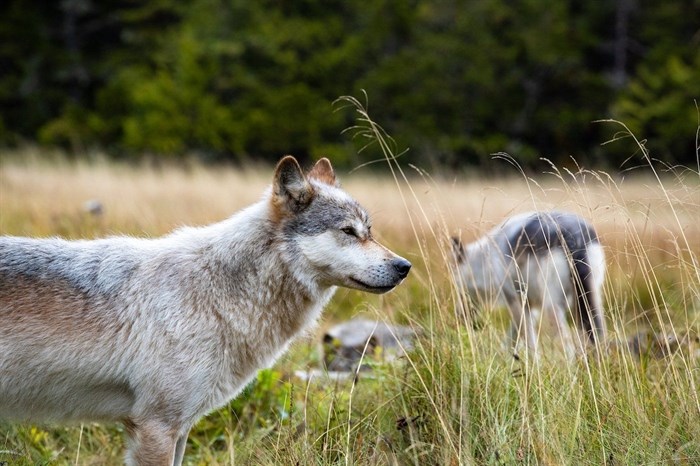
BC's most recent five-year wolf cull is set to expire with no indication the province has plans to end the controversial measure that doesn't support the long-term recovery of caribou, say critics.
Image Credit: Pacific Wild / Ian McAllister
June 15, 2025 - 9:00 AM
The BC government spent a decade killing wolves to protect caribou. Now, critics warn that despite questions about its effectiveness, ethics and impact on the rest of the environment, the government is moving to make the wolf cull a permanent part of its strategy.
Launched as a short-term emergency measure in 2015, the decade-long wolf cull is a morally outrageous tactic to divert public attention from the root cause of caribou declines — the province’s failure to significantly address habitat destruction — said Pacific Wild co-founder Ian McAllister.
“Wolves are just paying the ultimate price for total government negligence, and there's no end in sight,” he said.
The province’s five-year wolf cull cycle is set to expire with no indication the province has any plans to end or even limit the practice, he added.
‘New twist for war on wolves’
The future for caribou and wolves is looking even more dire given the federal and provincial plans to fast-track permitting and reduce environmental assessments for development, McAllister said.
“It’s obviously a new twist on the war on wolves,” he said.
Over the past decade, 2,543 wolves and 48 cougars have been killed, the Ministry of Water, Land, and Resource Stewardship (WLRS) told Canada’s National Observer in an email.
The ministry didn’t specify if or when the practice would end.
“Predator management will end when caribou populations recover to a level where they are expected to be self-sustaining,” the email said.
Heavy costs; poor returns
Killing wolves in large numbers has resulted in small and temporary gains for at-risk herds, while continuing to inflict great suffering on the highly social, intelligent predators, said Lesley Fox, executive director of The Fur-Bearers, an animal protection charity.
A total of 362 wolves were shot from helicopters this winter — marking the second-highest death toll since the province launched its predator reduction program in 2015, according to numbers the charity obtained through a freedom of information request.
The NDP government reneged on its promise to enact species-at-risk legislation with binding measures to protect critical habitat for threatened species, like BC caribou populations — which continue to lose the mature forests they rely on to logging, mining and oil and gas projects, as well as wildfire, Fox said.
The province uses euphemisms like “predator management,” or words like “culls” or “removals” to soften the message of what's really happening on the ground, she stressed.
She prefers a different descriptor.
“This is a mass slaughter of a keystone species that is integral to healthy ecosystems.”
Price of predator control
The ministry said the wolf and cougar culls came at a cost of about $1.4 million. An additional 15 wolves were live-captured and relocated to the US in Colorado to reintroduce the animals in the state.
The cost of the wolf cull over the past five years has averaged more than $1.5 million annually — with the killing of each wolf costing an estimated $6,000 or more.
The goal of the provincial wolf cull is to wipe out entire packs and reduce populations by more than 80 per cent, so there are fewer than three wolves per 1,000 square kilometres in caribou habitat, said McAllister.
Wolves are hazed from the air and semi-automatic weapons are used to shoot them, which limits accuracy, he said. The province also uses “Judas wolves” — where animals are fitted with GPS radio collars and released to rejoin their pack, so the entire group can be hunted down.
BC caribou roadmap unclear
The province issued a new caribou recovery strategy in November 2024 that includes prioritizing threatened herds most likely to recover — those with pre-existing habitat protections — over the next 20 to 40 years. The plan does not identify which herds will get attention.
In the short term, intensive population management measures, such as culling predators — like wolves and cougars, but also possibly bears and wolverines — are mentioned. Maternity penning, in which pregnant caribou and young calves are protected from predators and disturbances, is also recommended in the strategy.
The plan’s objectives include conserving and protecting key caribou habitats and accelerating the restoration of key damaged areas. However, the strategy offers no timelines for action, nor any caribou or habitat recovery targets, or what “short-term” means when it comes to killing wolves.
Wolf culls will only delay caribou extinction without habitat protection and recovery, said Rob Serrouya, co-director of the Wildlife Science Centre for Biodiversity Pathways.
However, wolves that follow typical prey like deer, moose and elk into disturbed forests come into contact with caribou, putting additional pressure on their populations, Serrouya said.
It will likely take decades to protect or restore vital habitat areas that sustain caribou populations, he said. The targeted removal of wolves in tandem with hunting the deer and moose — plus supplemental feeding of caribou or maternal penning — could prevent the most vulnerable herds from blinking out in the meantime.
There is little public appetite for wolf culls, which are ineffective and result in incremental gains for caribou, Fox said.
Close to 60 per cent of more than 15,000 people surveyed opposed predator reduction as a recovery measure, the province found before launching its five-year cull in 2021. The top three recovery measures supported were habitat protection, land restoration and managing industry operations.
However, opposition to wolf culls typically softens if they see they are paired with strong, effective habitat protections, Serrouya said.
— This article was originally published by Canada's National Observer
News from © iNFOnews, 2025